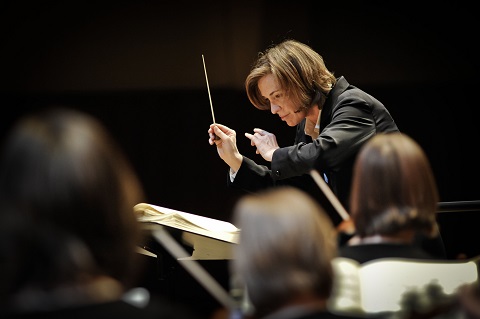 France Beethoven, Farrenc: Alexandra Conunova (violin), Natalie Clein (cello), David Kadouch (piano), Insula Orchestra / Laurence Equilbey (conductor). La Seine Musicale, Paris, 17.2.2018. (CC)
France Beethoven, Farrenc: Alexandra Conunova (violin), Natalie Clein (cello), David Kadouch (piano), Insula Orchestra / Laurence Equilbey (conductor). La Seine Musicale, Paris, 17.2.2018. (CC)

Beethoven – Triple Concerto in C Op.56
Louise Farrenc – Symphony No.3 in G minor Op.36
Paris’s new auditorium on the Île Seguin (in the west of the city, near Boulogne-Billancourt and Sèvres) is a remarkable building; it’s green credentials are high, too, with a sliding solar ‘sail’ that provides much of the complex’s energy in the daytime. Made of glass and timber laminate, the building is egg-shaped and decidedly modern. Inside the 1,100-seat concert hall, though, the effect is softer, more welcoming; terms which equally could be applied to the sound in the hall itself. Rarely have I heard a period orchestra sound so beautiful and yet heard so much detail come through.
Laurence Equilbey’s Insula Orchestra was the ensemble that gave the inaugural concert in this space, and it is in the Seine Musicale complex that the orchestra makes its home (an interview with Equilbey to accompany this review will soon be published; that interview took place in the orchestra’s offices). A period instrument ensemble, the sound of Insula is, at least in this space, remarkably beautiful and even mellow; it will be interesting to compare and contrast when the orchestra visits the Barbican centre in March. Founded in 2012 with funding from the Conseil Départemental des Hauts-de-Seine, Insula aims to present mainly music of the Classical and Romantic eras.
The orchestra was arranged with antiphonal violins, which further enhanced clarity. One constant of the concert was the excellence of the timpani playing (Koen Plaetinck), incisive and confident. The soloists played on the following period instruments: Alexandra Conunova on the 1735 Santo-Seraphino (Venice), Clein on the ‘Simpson’ Guadagnini of 1777 and Kadouch on an 1892 Pleyel. The soloists were laid out so that the pianist had his back to the other two soloists, a somewhat curious decision as it left him isolated both on a visual level and, indeed, on a musical one. The dovetailing between Conunova and Clein was spectacularly done on more than one occasion. Conunova, while occasionally moving towards the too quiet, has a sweet tone up top, where she is sure of tuning. Clein seemed to be on less than top form, unfortunately, her tuning sometimes wayward, something particularly noticeable in that admittedly cruelly exposed long opening solo in the central Largo. In that movement the honours really went to the Insula orchestra’s solo clarinettist, Alvaro Iborra, whose solos were ravishing. The finale’s polacca rhythms were beautifully projected by Equilbey, who was a consummate accompanist and interpreter throughout. Kadouch, a young pianist covered only a couple of times by Seen and Heard International (at the French Institute in London here and in Manchester here), was a little anonymous. His Pleyel instrument suited the piece well, with the right amount of heft when necessary but also with a fragility in comparison with modern piano behemoths; that worked well with the solo strings. If one has heard the piano part played with more character, Kadouch nevertheless provided a most musical account.
2018 is of course the Year of the Woman, and one of the wonderful results of that is the exposure of Louise Farrenc via the Insula Orchestra. Admired by both Berlioz and Schumann, Farrenc was a pupil of Reicha. A teacher at the Paris Conservatoire, her output includes three symphonies and some wonderful chamber music. In a review in 2002 of an ASV disc by the Schubert Ensemble of London of her piano quartets, I suggested that ‘perhaps the time is ripe for a reappraisal of the talents of French composer Louise Farrenc’. Now in 2018, we are offered another opportunity. The Third Symphony was premiered in Paris in 1847. I love the way the programme gave the duration of the Triple Concerto as 36 minutes but that of the Farrenc as ‘a good half hour’ (une bonne demi-heure). Scored for pairs of winds, a pair of horns, timpani and strings, this is a dramatic, expertly structured piece in the Austro-Germanic tradition (it is decidedly closer to that tradition than the French; in a spoken introduction, Equilbey referred to Farrenc as the ‘most German of French composers’).
Farrenc’s symphony could also have hardly asked for a more committed performance than this. The tautness of the musical argument of the first movement is remarkable, and there is a palpable Beethovenian dynamism to that movement’s Allegro, brilliantly projected on this occasion. The clarinet of Alvaro Iborra once more shone at the outset of the Adagio cantabile, a long, lovely line over a funereal tread. Moments of lightness and hyper-tenderness were offset by timpani strokes like gunshots. There was a Mendelssohnian light shining behind some of Farrenc’s harmonies, so this could be heard as ‘Mendelssohnian Beethoven’, the third movement Scherzo as more ‘Beethovenian Mendelssohn’. The Trio of this third movement was delightful, with its rapid string pizzicatos and deliciously slowed-down clarinet burbles. It was Robert Schumann, though, who seemed to hover over the finale’s opening. Here Farrenc writes at times with a wondrous simplicity, amply projected by the orchestra. If some passages of the finale offer rare instances of Farrenc padding her argument, this remains a highly impressive symphony. Equilbey’s concentration on detail while respecting each movement’s structure enabled the symphony to be heard in the best possible light.
There was an encore, its arrival heralded by the arrival of an extra two horns and two trumpets on stage: the delightful Overture to Auber’s Domino noir.
The Insula Orchestra visits the Barbican Centre on March 8; on that occasion, the piano soloist will be Alice Sara Ott; that concert will be preceded by a performance of some of Farrenc’s chamber music by members of the Insula Orchestra.
Colin Clarke